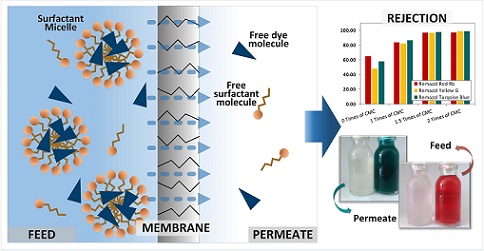Document Type : SI: ISET2019
Authors
1
Chemistry Department, Faculty of Science and Technology, Universitas Airlangga, Surabaya, Indonesia
2
Advanced Membrane Technology Research Center (AMTEC), UTM, Malaysia
3
Advanced Membrane Technology Research Centre, Universiti Teknologi Malaysia, 81310 UTM Johor Bahru, MALAYSIA.
4
Advanced Membrane Technology Research Centre (AMTEC), School of Energy & Chemical Engineering, Faculty of Engineering, Universiti Teknologi Malaysia, 81310, Skudai, Malaysia
5
Division of Nephrology and Hypertension, Dr Soetomo Hospital, Faculty of Medicine, Universitas Airlangga, Surabaya, Indonesia
Abstract
The adequacy of uremic toxins removal via hemodialysis treatment is essential for every kidney failure patient. To obtain hemodialysis adequacy, the effects of main polymer were investigated. The hollow fiber membranes were produced by using dry/wet spinning process from dope solution comprising PES as the main polymer, 3% poly(vinyl pyrrolidone) (PVP) in 1-methyl-2-pyrrolidone (NMP) at 40-cm air gap. PES loadings of 14, 16, and 18 wt.% were studied. The membrane morphology was characterized by using a scanning electron microscope (SEM) and the membrane properties were measured by using contact angle measurement (WCA). Membrane performance was evaluated by pure water flux (PWF), retention to bovine serum albumin (BSA), p-cresol and urea removal (URR) by using cross-flow permeation system. SEM analysis showed the asymmetric finger-like structure obtained for each polymer loading. The dense skin layer in the inner surface had thickened, followed by the increasing polymer weight loading. The 14 wt.% PES loading had a better pore size (116 nm) and porosity (74%). The WCA showed that the hollow fiber membranes studied were hydrophilic, and the utilization of 14 wt.% PES loading obtained better PWF (108.58 Lm-2h-1). However, this result had an impact on the impairment of BSA retention. The BSA retention for 14 wt.% PES loadings was 88.23%. The URR and p-cresol removal for 14 wt.% PES loading was higher (80.90% and 36.85% for 4 h, respectively) compared to others. As a conclusion, the percentage weight loading for polymer was a significant influence for morphology, membrane properties, and uremic toxins removal.
Graphical Abstract

Highlights
• The lower weight percentage loading of PES was studied to remove
urea and p-cresol.
• Percentage of PES was significant on morphology, properties and
toxins removal.
• The sample solution was conditioned to the real sample.
• Urea and p-cresol removal for 14 wt.% of PES loading was 80.90%
and 36.85% for 4h.
Keywords
Main Subjects

